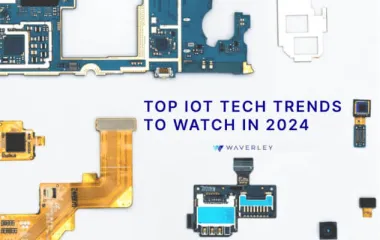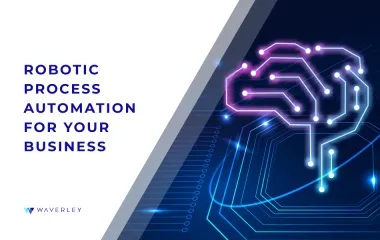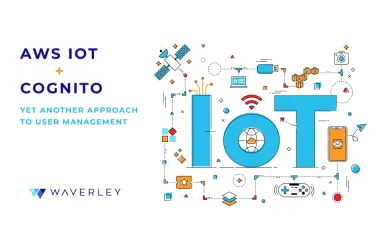How to Create an IoT App: Internet of Things App Development Tips
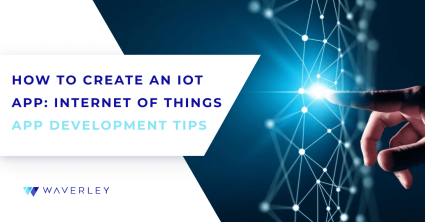
Contents
“Internet of Things” (IoT) describes a network of linked physical objects, such as cars, appliances, and other household items, which are equipped with electronics, software, sensors, and connectivity to enable data collection and exchange. Usually when hearing “IoT” people think about smart connected devices that make our lives easier, however there are also Internet of Medical Things and industrial kinds of IoT that help automate such areas as Construction, Manufacturing, Oil & Gas and other industries.
The ability to remotely control digital equipment and software also implies that it is possible to control various things located in different geographical locations. Distance and time do not matter.
Waverley has been creating scalable and user-friendly IoT apps for years now, satisfying the user needs by understanding key business objectives, helping our clients select technology stack, development methodology, and tools.
Our IoT development services include many services needed in the IoT industry, such as cloud infrastructure development, embedded software, middleware, hardware testing, Human-Machine Interfaces, etc. We create scalable, extensible architecture that is complemented by beautiful, carefully considered interfaces, and we offer all necessary assistance to help you meet your technological requirements.
We’ll give a general overview of the IoT app development process in this article, along with the important factors, procedures, and best practices to keep in mind, all based on our hands-on experience in this domain.
IoT Market: Trends and Areas
With new technology and applications appearing all the time, the IoT market is rapidly developing and by 2025, there may be up to 28 billion Internet of Things devices connected to the Internet, if technology advances at the present rate.
This technology works as a global infrastructure allowing advanced services to interconnect based on wireless communication technologies. Also, it develops the ability to communicate and perform different activities independently without any human intervention. With the arrival of Covid-19, all social environments such as banks, restaurants, schools and even medical centers have been affected, being forced to change their development methods. The new normality that the pandemic imposed has been beneficial for the IoT Market.
The growth of IoT is driven by advancements in technology such as 5G networks, cloud computing, and artificial intelligence. According to market research, the global IoT market size is projected to reach $1.5 trillion by 2027, with the industrial IoT sector accounting for the largest share of the market. With the increasing adoption of IoT technology by businesses and consumers alike, the growth of the IoT market is expected to continue in the foreseeable future.
Businesses and developers that want to take advantage of the prospects presented by the IoT market must comprehend these IoT trends and stay current on the most recent advancements. More and more web and mobile devices and sensors are being connected to the internet, which is driving the expansion of the Internet of Things (IoT) industry. The IoT realm also includes many iOS and Android apps that have penetrated many areas of our lives. The hardware industry keeps producing many kinds of wearables that revolutionize Healthcare and Wellness. Below we’ve summarized the trends that have been happening in the industry lately.
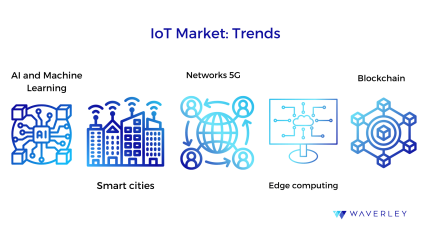
- AI (Artificial Intelligence) and Machine Learning: the use of Data Science is expanding, allowing machines and sensors to automatically analyze data in real-time and make intelligent decisions based on it, increasing productivity and cutting costs.
- Smart Cities: IoT applications are increasingly focusing on the creation of smart cities, where sensors and electronics are utilized to track and improve traffic, energy efficiency use, and public services. As a result, it is anticipated that both the environmental impact of metropolitan areas and the quality of life for inhabitants will increase.
- Blockchain: Blockchain makes it possible for mobile devices, hardware devices and sensors to communicate safely and independently. In addition to offering a transparent and impenetrable system, blockchain may be used to secure data and transactions.
- Edge Computing: Data processing and analysis can be done more quickly thanks to edge computing, which also lowers congestion and boosts productivity.
- Networks 5G: Delivering IoT device connectivity that is quicker and more reliable than ever. This will make it possible to use more advanced and complex applications, such as remote surgery robots and self-driving cars.
The IoT market is vast and encompasses many different areas. As the number of IoT devices and sensors continues to grow, it is expected that IoT will continue to impact many different industries and areas of our lives. Here are some of the areas where IoT is already making a significant difference:
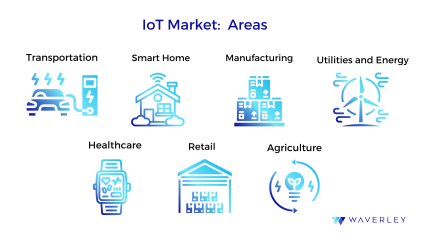
- Transportation: In order to monitor and improve traffic, vehicle performance, and fuel usage, transportation uses IoT sensors and devices. As a result, there can be less traffic, more safety, and less pollution.
- Smart Homes: Lighting, temperature, security, and entertainment are just a few of the many features of a home that may be monitored and controlled by IoT devices and sensors.
- Manufacturing: Here IoT is used to ensure better supply chain management, higher manufacturing efficiency, and equipment monitoring and control. This could minimize downtime and increase overall effectiveness.
- Healthcare: IoT devices, such as remote patient monitoring machines, smart wearables, and electronic health records, are used to monitor patient health, identify health issues, and enhance medical treatment.
- Retail: IoT devices are utilized in retail to enhance supply chain management, boost operational efficiency, and enhance the consumer experience. They offer many features like automatic checkout, smart shelving, and targeted marketing.
- Agriculture: To maximize farming of animals, irrigation, and crops. As a result, food harvests can increase, there’s less manual labor, and overall farming is done in a more proven and efficient way.
- Utilities and Energy Efficiency: To monitor and manage the energy use and consumption while lowering costs. This helps lessen the negative environmental effects of energy use by identifying and preventing outages.
How the IoT Apps Work
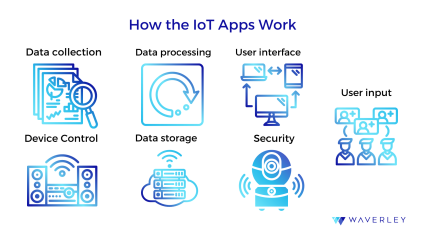
Let’s start this section with a great question: What will an IoT app be designed for? Simple, to communicate with and control IoT devices, which are physical objects such as sensors, cameras, thermostats, and other smart devices that can connect to the internet. And now, knowing that, how would it be done? We explain it here:
- Data collection: IoT devices use the internet to gather and transmit data to the IoT app. Temperature, humidity, location, motion, and other pertinent data may all be included in the data.
- Data processing: The IoT app examines and analyzes the data once it has been received in order to extract insightful information. To interpret the data, the app may employ a variety of algorithms, machine learning models, and other strategies.
- User interface: The IoT app presents the user with the processed data in an intuitive manner. Depending on the kind of device the person is using, it may be a mobile app, web, or desktop app.
- User input: The user can interact with the IoT app by providing input, such as setting a temperature, turning on a light, or adjusting the settings of the IoT device.
- Device Control: Based on the user’s input, the IoT app instructs the IoT devices to do certain actions. For instance, the IoT software instructs the lamp to turn on when the user wishes to turn on a light.
- Data storage: The IoT app may store the processed data in a database for future analysis and reference.
- Security: To prevent unauthorized access and data breaches, the IoT app must use secure communication protocols, authentication, and access control techniques.
In general, an IoT app connects to IoT devices, gathers data, processes it, displays it to the user, and then controls the devices based on input from the user. The main objective of the app is to manage and control the connected devices while offering a seamless and effective user experience.
Main Tech Stacks for Developing and IoT Application
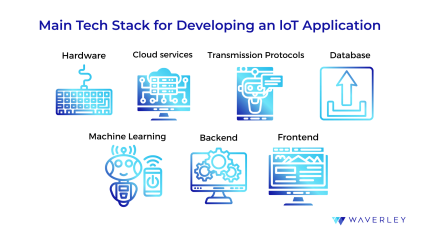
A combination of hardware and software technologies, including communication protocols, cloud services, databases, backend, frontend, and machine learning technologies, are needed to develop an IoT application. The IoT application’s individual needs and capabilities will determine the tech stack to use. Below are some of the main tech stacks used for developing an IoT application:
- Hardware: IoT hardware components could include a range of things such as sensors, CPUs, communication modules, and power supplies. The type of IoT device, its capabilities, and the desired functionality determine the hardware technology stack.
- Cloud services: Cloud services are frequently used by IoT applications for data processing, analysis, and storage. To manage the enormous amounts of data produced by IoT devices, cloud services like Amazon Web Services (AWS), Microsoft Azure, and Google Cloud Platform offer a scalable, dependable, and secure infrastructure.
- Transmission Protocols: IoT applications transfer the data back and forth with the device using a variety of communication protocols. Protocols for communication include HTTP, WebSocket, CoAP, MQTT, and others.
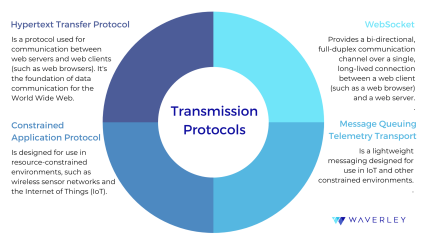
- Machine Learning: Machine learning techniques may be used by IoT applications to gain insights from the data produced by IoT devices. This can be accomplished using machine learning tools like TensorFlow, OpenCV, PyTorch, and scikit-learn. Our data engineers have worked on a variety of machine learning projects providing Machine Learning and AI services for IoT companies and have identified some major challenges that clients encounter in this technological field especially related to collecting data for ML models.
- Backend: Is in charge of controlling the communication between the application and IoT devices. The backend may be created using tools like Java, Python, or Node.js.
- Frontend: A user interface that allows people to interact with linked devices and view the data they produce. Technologies like React, Angular, or Vue may be used to construct that.
- Database: Data storage can be accomplished using database technologies like MySQL, PostgreSQL, and MongoDB.
9 Steps to Develop an IoT App
Following these steps, you can create an IoT application that is scalable, efficient, and user-friendly. Whether you are a developer or an entrepreneur this guide will provide you with just the right steps needed to bring your IoT application to life. So, let’s get started and learn how to develop an IoT application in less than 10 steps. Build an effective and efficient IoT application that fits your goals by paying attention to these general procedures.
Step 1. Define the Requirements (What?)
Defining the requirements for an IoT app is a critical step in the development process. It involves identifying the purpose of the application, its target users, and the specific features that it should offer.
The first step is to determine the reason for developing the app. Is it for home automation, industrial control, or healthcare monitoring? Understanding the purpose of the app will help you determine the specific features it should have. Then, you will identify the target users because if you know who will be using the app, for example, if the app is for seniors, the interface should be easy to use. With respect to the characteristics and functionalities, if we have already defined the objective or purpose of the application and the question arises for the users, what is going to be offered? So, the characteristics must be planned and with this the hardware, it is important to determine the type of hardware that will be required to ensure that the app can communicate effectively with the devices it is intended to control.
And finally don’t forget to determine the communication protocol, which means, the way to connect the IoT app to the hardware to be controlled, for example, Wi-Fi or Bluetooth.
Step 2. Choose an IoT Platform
The platform serves as the foundation for your app, providing the necessary tools for data collection, processing, and analysis. There are several factors to consider including scalability, security, interoperability, and ease of use. Some popular IoT platforms include AWS IoT, Microsoft Azure IoT, Google Cloud IoT, and IBM Watson IoT.
It is simpler to create and launch your IoT app using these platforms because they provide a variety of features like device management, data storage, and analytics. The prerequisites and objectives of your app must be aligned with the IoT platform you choose. Additionally, it’s critical to confirm that the framework you select is compatible with the hardware elements and networking standards employed by your IoT devices.
By selecting the right IoT platform, you can simplify the development process, reduce costs, and ensure the success of your IoT app.
Step 3. Get the Correct Hardware Components (With?)
Based on the use case and specifications, choose the sensors, microcontrollers, and actuators that will be required for your IoT application; these must be compatible with the platform and the protocol.
Once you have identified the necessary hardware components, choose a reliable supplier. Look for suppliers with a good reputation, excellent customer service, and a track record of providing high-quality components.
Before incorporating the components into your app, test them to ensure they are working correctly. This will help you avoid any compatibility issues or unexpected behavior when integrating them with your IoT platform. And, finally, verify that the hardware components are compatible with your IoT platform and communication protocols. This will ensure that the devices can communicate with each other and the app can function as intended.
Step 4. Choose the Network Protocol (Which?)
Choose a network protocol like MQTT, CoAP, HTTP, or Zigbee that is appropriate for your use case.
The network protocol enables communication between the IoT devices and the app, and there are several factors to consider when selecting the appropriate protocol. These factors include the range, bandwidth, power consumption, security, and interoperability of the protocol. Some popular IoT network protocols include Wi-Fi, Bluetooth, Zigbee, and LoRaWAN.
- Wi-Fi provides high bandwidth and range, making it ideal for IoT devices that require high-speed data transfer.
- Bluetooth, on the other hand, is suitable for low-power devices with short-range requirements.
- Zigbee is ideal for large-scale deployments, while LoRaWAN provides long-range, low-power connectivity.
Selecting the right network protocol, you can ensure that your IoT app functions effectively with minimal power consumption and maximum security.
Step 5. Develop the Software
Developing a software component for an IoT app requires following specific steps to ensure its functionality and efficiency.
First, select a suitable programming language for developing the software component, some popular options include Python, C++, and Java. Then, a data processing and analysis module should be developed to receive, filter, organize, and analyze data from IoT devices. Later, it’s time to develop the user interface, allowing end-users to interact with the app, visualize data, and control the IoT devices. To ensure data and device protection, appropriate security measures such as encryption, authentication, and authorization must be implemented.
Moreover, testing the software component is necessary to ensure its compatibility with the IoT devices and network protocol.
Finally, after verifying its functionality, deploy the software to the target environment, such as a cloud platform or a local server.
Step 6. Connect the Hardware and Software
To ensure that the software and hardware can communicate effectively, developing an IoT app involves connecting all the components. The hardware devices collect data, while the software processes and analyzes the data to provide insights and enable control of the IoT devices.
To achieve this:
- Configure the hardware devices with the necessary software and settings to enable communication with the software component.
- Integrate the communication protocol, such as Wi-Fi or Bluetooth, between the hardware devices and the software component. Implement device management, such as remote firmware updates and device diagnostics, to ensure that the hardware devices are functioning correctly.
- Test the connection between the hardware and software components to ensure that they can communicate effectively.
- Implement monitoring and alerting mechanisms to detect and respond to any issues that may arise with the connection between the hardware and software components.
Step 7. QA – Test the app
It’s not just the seventh step. You shouldn’t think about testing only once you’ve completed the previous steps. In fact, it is a step that must be performed on an ongoing basis throughout the development process since it also serves to generate future updates and satisfy the needs of the end user. Everything must be working properly and if not, the experienced team will take care of solving any problem at any time.
The first step is defining the scope of testing, including the features and functionalities that need to be tested. Next, it is necessary to develop test cases that cover all aspects of the app, including functional and non-functional testing. After developing that, execute them to identify any bugs, errors, or issues in the app. Record and track all issues identified during testing and ensure that they are resolved before releasing the app. Perform compatibility testing on different devices and operating systems to ensure that the app works as expected on all platforms. Finally, conduct user acceptance testing to ensure that the app meets the end-users’ needs and expectations.
Step 8. Launch the IoT App
After testing and having considered that “everything is in order” you can launch your application to the public on your chosen platform. But it is important to have a detailed planning and execution plan. Here’s some advice for launching your IoT app.
You must define the launch strategy, including the target audience, channels for promotion, and key performance indicators (KPIs) to measure success. Then, optimize the app store presence, creating a compelling app listing, including engaging descriptions, screenshots, and videos that showcase the app’s features and functionality. After that, use social media, influencer marketing, and other marketing techniques to spread the word about the app and encourage downloads. Also, consider monitoring the app performance and user feedback to identify and fix any issues that may arise after launch. And finally, collect and analyze data to measure the app’s performance against KPIs and identify opportunities for optimization.
Step 9. Manage and Track the Application
Keep an eye on the program to make sure it is functioning properly and make any necessary modifications. Make sure that user data is protected by security measures.
This final step refers to the ongoing process of monitoring, maintaining, and optimizing the app’s performance after it has been launched.
It involves tracking various metrics related to the app’s usage and performance, analyzing user feedback and behavior, implementing updates and security measures, and ensuring that the app continues to meet the needs and expectations of its users. The goal of all of this is to ensure that it remains up-to-date, secure, and competitive, providing users with a seamless and enjoyable experience while also generating revenue for the developers. Here’s what you should work on here:
- Monitor the app (user engagement, app crashes, and other metrics that impact the user experience.)
- Update the app (with new features and bug fixes to ensure that it remains up-to-date and functional.)
- Analyze the user feedback and track their behavior (collect and analyze user feedback to understand user needs and identify areas for improvement, identify opportunities for engagement and monetization.)
- Implement security measures (to protect user data.)
How Much Does it Cost to Create an IoT App?
The complexity, functionality, the type of hardware for your IoT devices, the development team’s experience, and location are just a few of the variables that can have a significant impact on the cost of developing an IoT app. Some of the elements that can impact an IoT app’s development costs are listed below and can help you come up with an estimate:
- The number and types of devices: can vary depending on the specific application being developed. Generally speaking, IoT devices can be categorized into three groups:
- Sensors and Actuators: These are devices that collect data from the environment or interact with it.
- Gateways and Edge Devices: These are devices that sit between sensors and the cloud.
- Cloud Infrastructure: This is the infrastructure where data is stored, processed, and analyzed.
- Number of third-party integrations: For IoT applications to be able to gather, process, and analyze data from several sources, integration with a variety of third-party services, platforms, and devices may be necessary. For example: Cloud Platforms, Data Analytics Tools, Machine Learning Services, Communication Protocols, and APIs.
- Number of platforms: The most popular ones are Amazon Web Services (AWS) IoT, Azure IoT, Google Cloud IoT, IBM Watson IoT, ThingWorx, Kaa, and Particle. The cost of using these cloud services will depend on the amount of data and the level of processing required.
- The devices (hardware): In this case, all depend on the type of sensors, processors, communication modules, and power sources required.
- Team size and Hourly rates: As you know you will need an experienced and capable engineering and testing team working on your IoT app. The technology stack chosen, the architecture’s complexity, and the degree of interaction needed between the app and IoT devices will all affect the price of backend and frontend development. Also, the testing part will depend on the number of devices and use cases to be tested.
- Number of features: The functionality of an IoT app will depend on the specific use case and requirements of the application.
Considering the above points, some estimates of the costs are given below, taking into account the level of complexity that the application implies:
| Complexity | Estimates |
|---|---|
| Simple | USD$40,000-$60,000 |
| Medium | USD$60,000-$150,000 |
| Complex | USD$150-000 to over $300,000 |
The Challenges of Building IoT Applications
Here are some of the main challenges in developing IoT applications:
- Security: IoT devices are vulnerable to security breaches. The developers change use encryptions, secure protocols and control mechanisms to violations and eliminate unauthorized access.
- Scalability: We know that IoT apps generate a lot of data, which may be challenging to handle and process. The engineering team needs to take care of the flexible data storage and all the necessary backups.
- Data Management: All the data generated will be collected, processed, and stored in a secure and scalable manner.
- Interoperability: IoT uses many communication protocols and data formats. So, the developers must ensure that these devices can communicate seamlessly with the apps and other devices.
- Reliability: Your development team must ensure that the application can handle any load and potential issues and still provide reliable and consistent functionality.
- Costs: Yes, maybe it is expensive but it all depends on the required specialized hardware, software, and expertise. Find a balance between the cost of development and value that your business will receive from the results.
- User experience: Develop IoT applications that are intuitive and user-friendly, because modern users are often ruled by emotions when it comes to determining the future of your app.
Waverley’s Experience in IoT Application Development
As a software development company with skilled IoT development teams in LatAm and Europe, we create award-winning IoT solutions for startups and enterprises. To help you fulfill your technology objectives, we provide a turnkey solution, from a scalable, flexible architecture to an elegant and carefully designed interface.
We have worked with a wide range of frameworks, microchips, boards, sensors and other technologies, delivering smart home security systems, personalized music players, wearable ring-shaped fitness monitors, social robots, and much more. About our technologies, with years of expertise and a solid foundation in C, C++, multithreading, and TCP/IP, our team of embedded software engineers is highly qualified to bring to market an IoT product of any complexity. Additionally, we have in-depth knowledge of tried-and-true designs, network protocols, and other subjects.
One of our biggest projects is Jibo, an MIT startup where our team of engineers assisted in the development of the first social robot for the home.
Our team built a reliable and flexible architecture, from cloud storage and embedded software to mobile apps for user onboarding and robot control. The client’s initial Waverley team was small and concentrated on front-end development. Within a year, the scope of this team’s work grew to include Android components, server-side work, the creation of new product firmware, and product QA.
Also, we can mention the work we did in Home Automation, the client is a market leader in the development of smart home solutions using conventional security systems. For this client we created a smart home panel, which allowed us to control electricity, heating and home security.
Overall, Waverley has worked with a wide range of IoT devices and applications, including connected sports gear, smart kitchen appliances, a range of wearables, even an industrial robotics solution for Construction.
Conclusion
In conclusion, developing an IoT app demands a solid strategy based on your business objectives and user needs, identifying the appropriate IoT platform and programming languages, developing a user-friendly interface, and putting in place effective security measures. A multidisciplinary approach mixing knowledge of hardware, software, and user experience design is necessary for the success of IoT app development. With the right team and correct tools in place, anyone can develop a successful IoT app that has the power to change industries and improve people’s lives.
We understand that it’s a lot to take in, especially if you’ve never particularly worked on such apps yourself, which is why our development team is happy to step in at any stage and consult you on the architecture, hardware selection, tech stack and other aspects. To schedule a free initial consultation with one of our architects, please contact us using the form below.
FAQ
How do IoT applications work?
Connecting multiple devices to a central platform that takes and analyzes data lets IoT applications to function, supporting the automation of various processes or the development of new services. The items, which could be sensors, actuators, or other things, have network connectivity built in and are able to gather and send data to the IoT platform. The data is then examined by the IoT platform, enabling automated decision-making, insights, or real-time decision-making. That involves the Data collection, transmission, processing and visualization as well as varying degrees of automation.
What programming languages are used to develop IoT apps?
The most commonly used programming languages for IoT applications development are Java, C, C++, Python, and JavaScript.
What is needed for an IoT application development?
The specific requirements will depend on the use case and the application requirements. It is important to consider the following list: IoT Platform because it provides the necessary tools and services to develop, deploy, and manage IoT devices and applications. The Hardware Components, such as sensors, actuators, and microcontrollers, to collect and transmit data. Communication Protocols: Communication protocols like Bluetooth, Wi-Fi, and MQTT. User Interface because it allows users to interact with and control the IoT devices. Finally consider data security that includes encryption, user authentication and regular updates to address vulnerabilities. Overall, the most important thing you need to build an app is an experienced team which can guide you through the process and deliver a high-quality result.
How long does it take to develop an iot app?
All depends on the app complexity, team composition, hardware requirements, etc.. Based on these factors: the scope of the protection, the technology stack, the design and UX part, the testing one and the developer team expertise, the development time for an IoT app can range from a few weeks to several months or even longer.
Start your IoT project with us.


